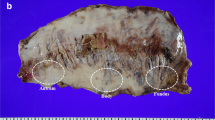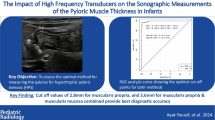Abstract
Background
The aim of this study was to determine the relationship between gastric wall thickness and BMI.
Methods
Bariatric surgery patients undergoing a pre-operative screening EGD and patients undergoing endoscopic ultrasound for non-gastric pathology were prospectively enrolled in the study. Patients underwent endoscopic ultrasound evaluation with measurements of gastric wall thickness at six areas of the stomach. The primary outcome was the correlation of BMI and mean gastric wall thickness.
Results
Twenty-four patients were enrolled in the study. Eight patients were excluded due to endoscopic abnormalities of the stomach (five) or intolerance to the procedure (three). Ten patients with a normal BMI and six obese patients were included in the analysis. BMI in the non-obese group was 23.8 ± 2.5 kg/m2 compared to 54.7 ± 14.6 kg/m2 in the obese population. The average gastric wall thickness amongst all subjects was 3.27 ± 0.42 mm. Mean gastric thickness in the non-obese group was 3.25 ± 0.45 mm compared to 3.30 ± 0.39 mm in the obese group (p = 0.41). When both groups were combined, there did not appear to be a linear relationship between mean thickness and BMI (R 2 = 0.005). There was no linear relationship between gastric wall thickness and waist circumference (R 2 = 0.02).
Conclusion
There was no significant correlation between gastric wall thickness and BMI. Mean gastric wall thickness of endoscopically normal stomachs was in the range of 3–4 mm.

Similar content being viewed by others
References
Sturm R. Increases in morbid obesity in the USA: 2000–2005. Public Health. 2007;121 7:492–6.
Rapaccini GL, Gambassi G, et al. Gastric wall thickness in normal and neoplastic subjects: a prospective study performed by abdominal ultrasound. Gastrointest Radiol. 1988;13 3:197–9.
Pickhardt PJ, Asher DB. Wall thickening of the gastric antrum as a normal finding: multidetector CT with cadaveric comparison. AJR. 2003;181:973–9.
Henry JA, O'Sullivan G, Pandit AS. Using computed tomography scans to develop an ex-vivo gastric model. World J Gastroenterol. 2007;13 9:1372–7.
Gordon SJ, Rifkin MD, Goldberg BB. Endosonographic evaluation of mural abnormalities of the upper gastrointestinal tract. Gastrointest Endosc. 1986;32 3:193–8.
Botet JF, Lightdale C. Endoscopic sonography of the upper gastrointestinal tract. AJR Am J Roentgenol. 1991;15 6(1):63–8.
Ginès A, Pellise M, Fernández-Esparrach G, et al. Endoscopic ultrasonography in patients with large gastric folds at endoscopy and biopsies negative for malignancy: predictors of malignant disease and clinical impact. Am J Gastroenterol. 2006;101 1:64–9.
Ren CJ, Horgan S, Ponce J. US experience with the LAP-BAND system. Am J Surg. 2002;184 6B:46S–50S.
Kimmey MB, Martin RW, Haggitt RC, et al. Histologic correlates of gastrointestinal ultrasound images. Gastroenterology. 1989;96 2 Pt 1:433–41.
Huh CH, Bhutani MS, Farfán EB, et al. Individual variations in mucosa and total wall thickness in the stomach and rectum assessed via endoscopic ultrasound. Physiol Meas. 2003;24 4:N15–22.
Csendes A, Burgos AM. Size, volume and weight of the stomach in patients with morbid obesity compared to controls. Obes Surg. 2005;15 8:1133–6.
Gossios KJ, Tsianos EV, Demou LL, et al. Use of water or air as oral contrast media for computed tomographic study of the gastric wall: comparison of the two techniques. Gastrointest Radiol. 1991;16 4:293–7.
Scatarige JC, DiSantis DJ. CT of the stomach and duodenum. Radiol Clin North Am. 1989;27 4:687–706.
Vazquez Roque MI, Camilleri M, Stephens DA, et al. Gastric sensorimotor functions and hormone profile in normal weight, overweight, and obese people. Gastroenterology. 2006;131 6:1717–24.
Geliebter A, Hashim SA. Gastric capacity in normal, obese, and bulimic women. Physiol Behav. 2001;74:743–6.
Torgersen J. The muscular build and movements of the stomach and duodenal bulb. Acta Radiol. 1942;45 suppl:1–100.
Author information
Authors and Affiliations
Corresponding author
Rights and permissions
About this article
Cite this article
Larsen, M.C., Yan, B.M., Morton, J. et al. Determination of the Relationship Between Gastric Wall Thickness and Body Mass Index with Endoscopic Ultrasound. OBES SURG 21, 300–304 (2011). https://doi.org/10.1007/s11695-009-9839-1
Received:
Accepted:
Published:
Issue Date:
DOI: https://doi.org/10.1007/s11695-009-9839-1




